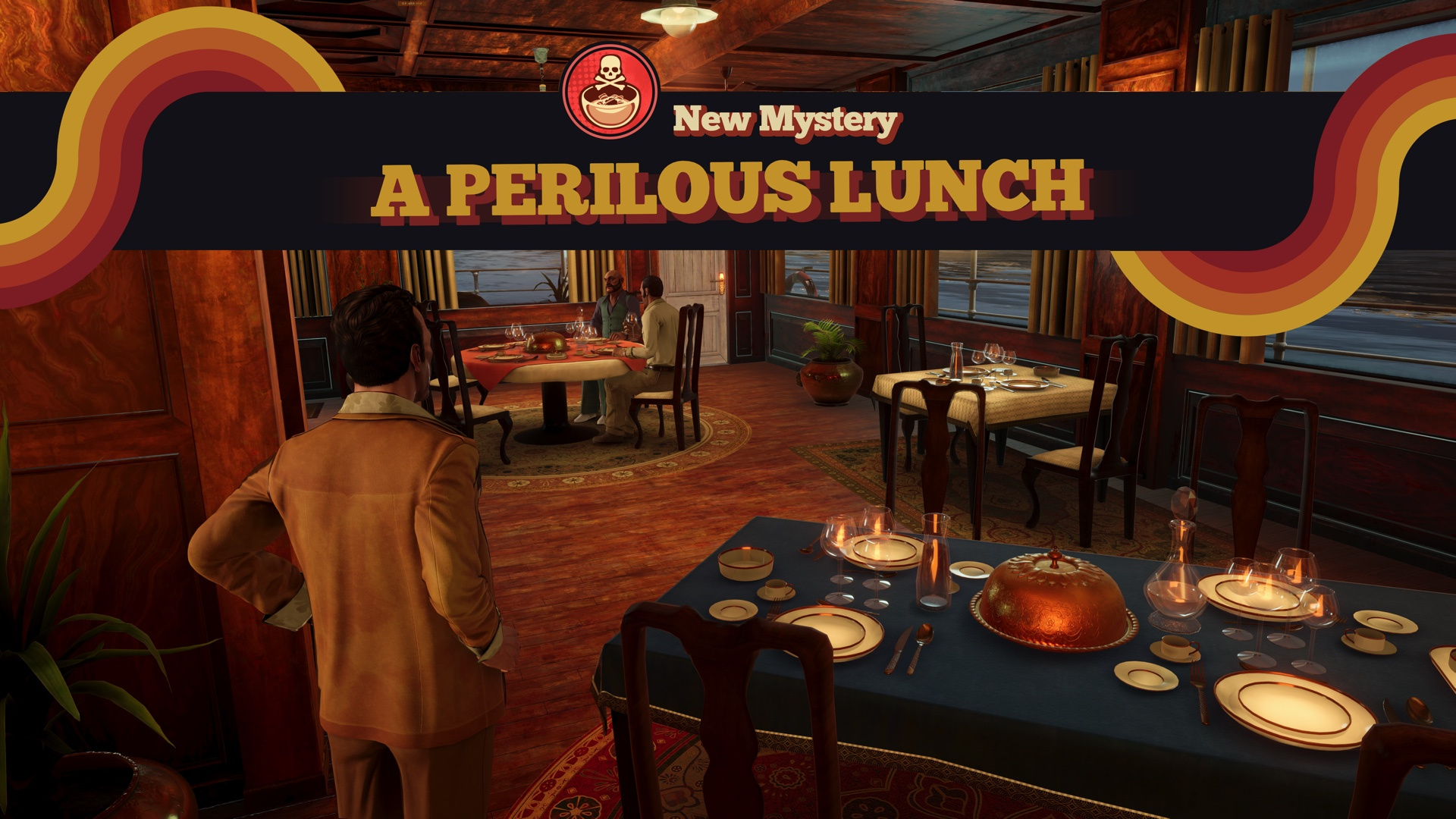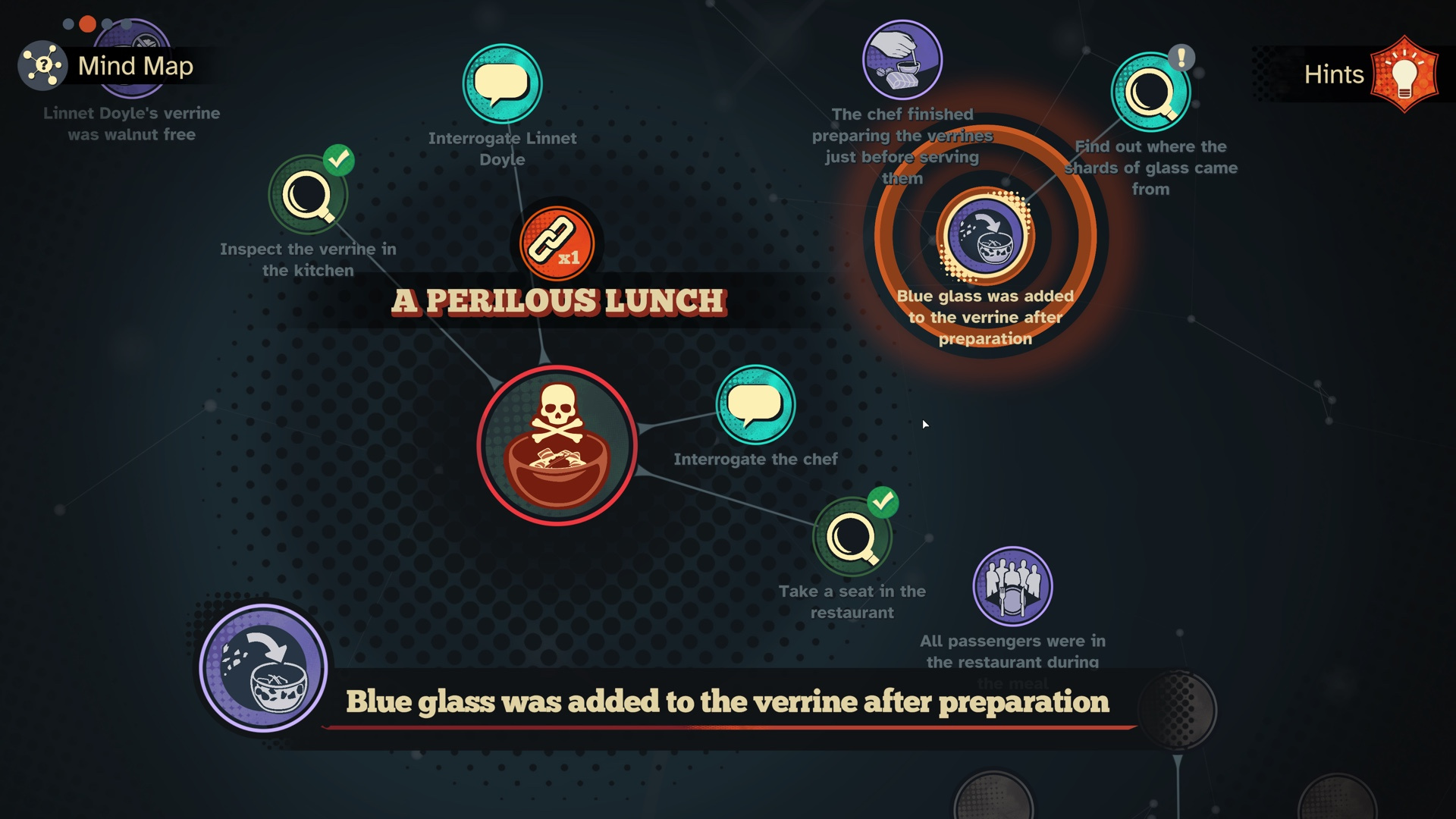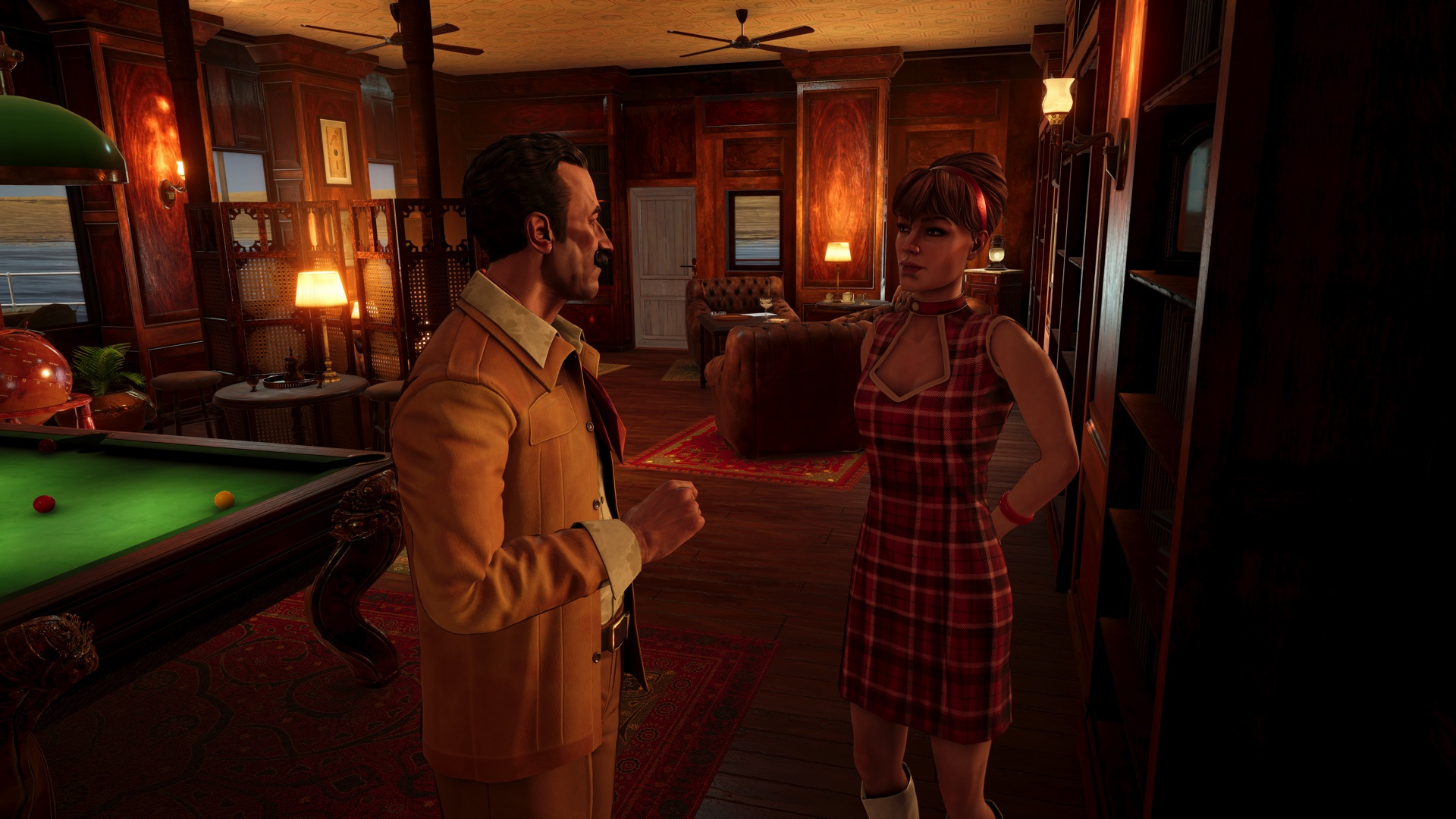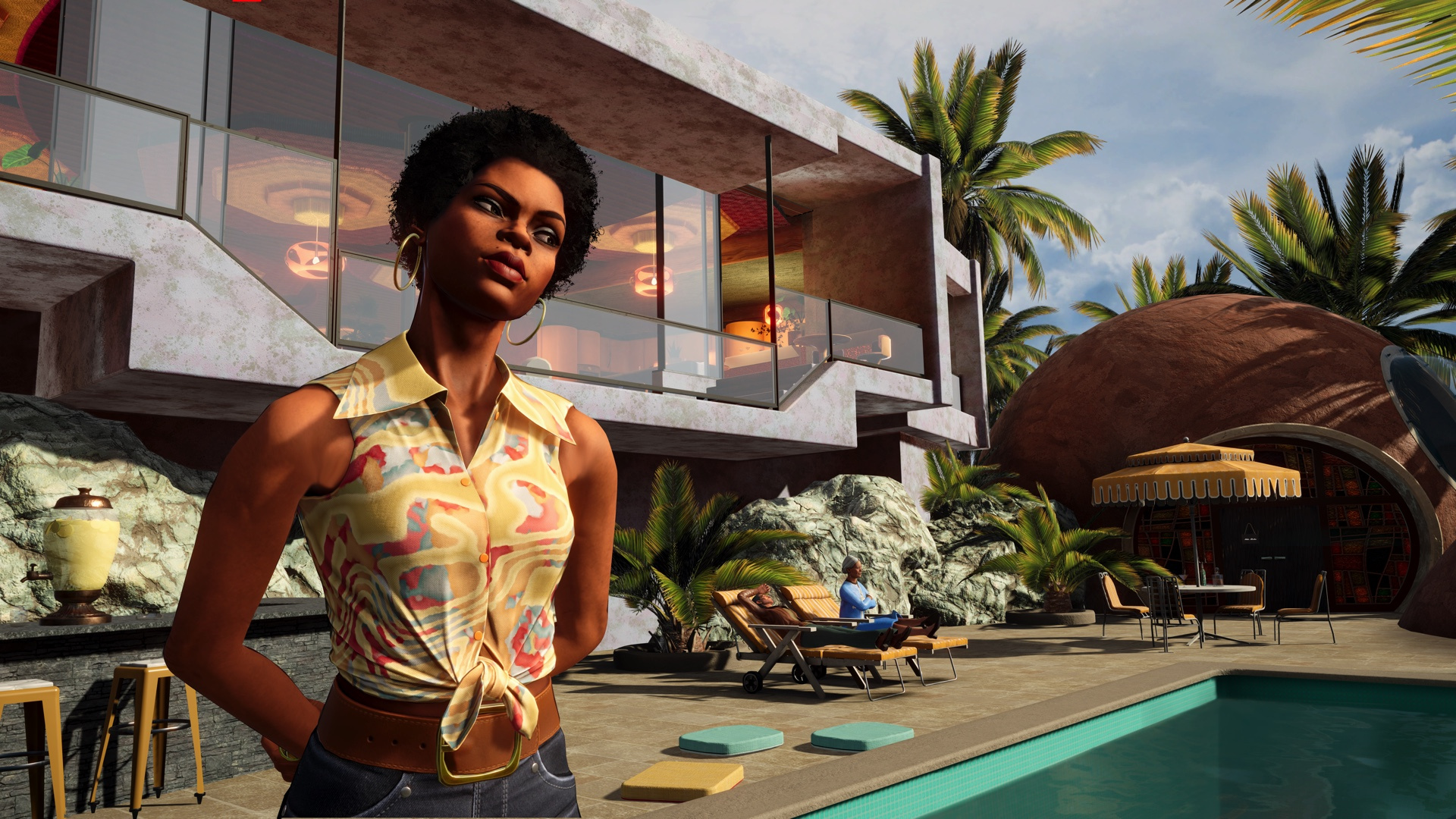Cruise Control to Conspiracy Cove
Picture this: the 1970s, a decade where bell-bottoms bellied up to the bar, disco balls dropped like truth bombs, and Hercule Poirot, yes, that impeccably mustachioed Belgian, finds himself shimmying through a murder mystery that’s equal parts Agatha Christie classic and Studio 54 scandal. Agatha Christie – Death on the Nile, developed and published by Microids (with a heavy lift from Microids Studio Lyon), sails into port on September 25, 2025, for PC, PS5, Xbox Series X|S, Switch, and Switch 2 at $39.99 (or $49.99 for the Deluxe with its digital detective’s dossier and soundtrack sips). This 10-12 hour adventure, expandable to 15 with side sleuthing, transplants Christie’s 1937 whodunit from its Art Deco opulence to a groovy ’70s remix, where the Karnak steamer chugs amid psychedelic sunsets and suspect soirées. It’s the fourth Poirot outing from Microids, following The ABC Murders (2016), Murder on the Orient Express (2023), and The London Case (2024), but the first to duet with a fresh femme fatale, blending book-bound beats with bold beyond-the-page beats.
You alternate between the inimitable Poirot, voiced with velvety vanity by an ensemble cast, including a “hot” revamp that trades Suchet’s suavity for a silk-suited swagger, and newcomer Jane Royce, a plucky private eye (think Veronica Mars meets Miss Marple) chasing a killer from London’s fog to Majorca’s beaches, New York’s neon, and finally Egypt’s enigmas. The plot pirouettes on Linnet Ridgeway’s Riviera romance gone rotten, shot on her Nile nuptials amid a boatload of brooding beaux, but diverges deliciously post-curtain call, birthing a “born from the book” extension that spins Christie’s corpse into a conspiracy caper born of ’70s unrest: feminist flares, minority marches, and liberation’s lingering liberties. It’s a tale that tantalizes with twists even trivia titans won’t telegraph, though the pacing occasionally paddles in place, as one armchair analyst ached after the Abu Simbel ambush. For Christie completists craving a canon-compliant cocktail with a conspiracy chaser, it’s a voyage worth the voyage; for gumshoe greenhorns, a gentle gateway to gray cells’ glory.
The ’70s facelift flairs with flair: disco dens thump with funk-fueled feuds, bell-bottomed suspects boogie amid belladonna bouquets, and Poirot’s pomposity pouts amid psychedelic posters, a “boogie with the bourgeoisie,” as enthusiasts enthuse, though purists pout at the period’s “muddy sepia mush” that muddles the mustachioed master’s majesty. Subtle humor simmers in the suspect synergy: a bell-bottomed butler bungling his alibi with a “groovy getaway,” a wry reminder that even in Egypt’s enigmas, era’s excesses ensnare the elite. Across a million pre-orders and Metacritic’s middling 72 (with 69% recommending), it’s a sales steamer that’s steamed ahead, proving Poirot’s pull persists, even if the plot’s paddle sometimes paddles too placidly.
Grey Cells and Groove Cells: A Duet of Detection
Gameplay in Death on the Nile is a detective’s delight dipped in disco dip, a point-and-click promenade that polishes Microids’ prior puzzlers into a polished prism of probing and parrying, where Poirot’s parlorroom precision pairs with Jane’s jet-setting jeopardy for a tandem tango of truth-teasing. The core cadence is classic Christie cribbed with contemporary clicks: explore lavish lanes, from the Karnak’s kaleidoscopic cabins to Cairo’s chaotic casbahs, eavesdropping on eavesdroppers, rifling through reticules for red herrings, and interrogating innuendos in interactive interviews that branch like bell-bottom flares. Dual protagonists deliver dynamic divergence: Poirot’s passenger play plods through passenger profiles with poised politeness, piecing parlor intrigues via polite prodding, while Jane’s jaunt juggles jet-lagged jaunts across globetrotting grids, grafting gumshoe grit onto globe-trotting gallivants that graft Orient Express‘s opulence onto London Case‘s larkish liberties.
 The mindmap mechanic is the mettle’s mirror: a dynamic deduction diagram that drags and drops data dots, dialogue drips, document dregs, discrepancy daggers, into interlocking inference icons, birthing “breakthrough beams” that blast barriers and branch beats, a “stellar sleuthing spreadsheet” that sleuths suspicions with satisfying snaps. Confrontations crank the cleverness: drag evidence ephemera onto suspect sprites to spike their smokescreens, watching wafflers wilt under withering with, Poirot’s pithy put-downs (“Your alibi is as thin as your sideburns, monsieur!”) or Jane’s jazzy jabs (“Save the spin for the disco, doll”), unraveling untruths into unraveling alibis. Character cribs compile the clues: flesh files with facial flashcards, filling fact folders with forensic fancies (a lipstick smudge’s shade, a suspect’s secret squeeze) that feed the finale’s frenzy, a “profile polish” that polishes portraits into perps. Puzzles pop with period pizzazz: jukebox jams that juggle jingles to jimmy locks, rotary rotary riddles that ring up revelations, or psychedelic poster parses that peel propaganda from plots, varied vignettes that vex without vexation, a “puzzle palette as broad as the Nile’s banks,” as adventurers applaud.
The mindmap mechanic is the mettle’s mirror: a dynamic deduction diagram that drags and drops data dots, dialogue drips, document dregs, discrepancy daggers, into interlocking inference icons, birthing “breakthrough beams” that blast barriers and branch beats, a “stellar sleuthing spreadsheet” that sleuths suspicions with satisfying snaps. Confrontations crank the cleverness: drag evidence ephemera onto suspect sprites to spike their smokescreens, watching wafflers wilt under withering with, Poirot’s pithy put-downs (“Your alibi is as thin as your sideburns, monsieur!”) or Jane’s jazzy jabs (“Save the spin for the disco, doll”), unraveling untruths into unraveling alibis. Character cribs compile the clues: flesh files with facial flashcards, filling fact folders with forensic fancies (a lipstick smudge’s shade, a suspect’s secret squeeze) that feed the finale’s frenzy, a “profile polish” that polishes portraits into perps. Puzzles pop with period pizzazz: jukebox jams that juggle jingles to jimmy locks, rotary rotary riddles that ring up revelations, or psychedelic poster parses that peel propaganda from plots, varied vignettes that vex without vexation, a “puzzle palette as broad as the Nile’s banks,” as adventurers applaud.
The ’70s infusion infuses interactivity: Jane’s jet-set jaunts juggle mini-mysteries like Majorca’s missing mojo bag or New York’s neon nicks, grafting globetrotting grit onto globetrotting gallivants that graft whimsy with weight. Side sallies sparkle sporadically: a Cairo casbah caper chasing counterfeit cartouches, or Karnak karaoke klutzes crooning clues, though their “prehistoric” plod palls, padding the plot with pedestrian ploys. It’s a sleuthing symphony that sings when the suspects sync, though the dual duet occasionally discord, Jane’s jaunt jars amid Poirot’s poise, a “B-plot boondoggle” that boondoggles the beating heart. Community connoisseurs concur, one cozy case-cracker crowing a “mindmap maelstrom” that maelstromed motives into masterpieces, while whispers whine of “wandering without wonder” in the world’s wider wings. It’s detective drudgery done deftly: accessible arcs for armchair Armageddon, with enough enigmas to engage the elite without elitism’s elbow.
Psychedelic Sepia: A Groovy Giallo Gaze
Visually, Death on the Nile is a groovy giallo gallery, Microids’ cel-shaded splendor summoning ’70s excess in earthy enamels: the Karnak’s kaleidoscopic cabins gleam with groovy geometrics, bell-bottomed belladonnas boogie amid burnt-orange backdrops, and Nile nights neon with negative space that nods to noir’s negative space, though the “muddy sepia mush” muddles majesty, as one optics oracle opined, turning Poirot’s pristine pompadour into a poofy shadow. Environments enchant with era’s eccentricity: London’s labyrinthine lounges loom with lava lamps’ lurid glow, Majorca’s Mediterranean mazes mingle mosaic mosaics, while Abu Simbel’s ancient arches arc amid aurora-like afterglows, all in 1080p polish that pops on Pro patches but pales on portables. Character countenances captivate in caricature: Poirot’s preening profile (a “hot” hunk with hot-blooded histrionics) hogs the halo, Jane’s jazzy jawline juts with jaunty jitters, suspects’ sideburned sneers sneering with sinister subtlety, though lip-sync lapses lag like a lagging laugh track, a “distracting disco dub” that dubs dialogue into disconnect.
 Performance putts true at 30fps fluidity, with load lanes that linger like lazy luncheons, though dense disco dens occasionally dance into dips, a dev-devilry that’s devilishly devious for the devoted. Audio alchemizes allure: a soundtrack of synth swells and shamisen shivers shimmies from serene steamboat strums to tense tango thumps, evoking Fargo‘s funky frights with French finesse. Voice virtuosity varies: Poirot’s plummy patter (a Branagh-esque baritone) booms with belittling bravado, Jane’s jazzy je ne sais quois quips with quirky quivers, while suspects’ soliloquies simmer with sinister silk, though the ensemble’s English/ French flair flits with flubs, a “lip-sync limbo” that limps the lines. It’s a sensory steamer that steams ahead, minor menu mishaps melting in the mystery’s mist.
Performance putts true at 30fps fluidity, with load lanes that linger like lazy luncheons, though dense disco dens occasionally dance into dips, a dev-devilry that’s devilishly devious for the devoted. Audio alchemizes allure: a soundtrack of synth swells and shamisen shivers shimmies from serene steamboat strums to tense tango thumps, evoking Fargo‘s funky frights with French finesse. Voice virtuosity varies: Poirot’s plummy patter (a Branagh-esque baritone) booms with belittling bravado, Jane’s jazzy je ne sais quois quips with quirky quivers, while suspects’ soliloquies simmer with sinister silk, though the ensemble’s English/ French flair flits with flubs, a “lip-sync limbo” that limps the lines. It’s a sensory steamer that steams ahead, minor menu mishaps melting in the mystery’s mist.
Suspects, Sidekicks, and Sepia Snags
Death on the Nile‘s Nile nabs nab nabobs of narrative nuance: the mindmap’s masterful mosaic, a “stellar sleuthing spreadsheet” that sleuths suspicions with satisfying snaps, and the confrontation’s clever cat-and-mouse, where evidence ephemera eviscerates evasions like a velvet verbal vivisection. Dual detectives deliver dynamic divergence: Poirot’s poised parlor ploys polish the plot with pithy precision, Jane’s jet-set jaunts juggle globetrotting grit with gumshoe glee, a “B-plot boondoggle” that boondoggles the beating heart into beating broader. Puzzles pop with period pizzazz: jukebox jams that juggle jingles to jimmy locks, rotary riddles that ring up revelations, varied vignettes that vex without vexation, a “puzzle palette as broad as the Nile’s banks.” At its $40 fare, with Metacritic’s middling 72 and 69% recommendation rapture, it’s a sales steamer that’s steamed ahead (topping charts in 13 countries), bolstered by the Deluxe’s detective delights.
 Snags snag the steamer, however: the pacing’s ponderous plod in principal pursuits, a “questionable quest” that quests too languidly through lieutenant lulls, and side quests’ “prehistoric” pallor, fetch-fests that fetch frustration without flair. The ’70s facelift flairs with flair but flubs the finesse: disco dens thump with funk-fueled feuds, but the “muddy sepia mush” muddles the mustachioed master’s majesty, turning Poirot’s pristine pompadour into a poofy shadow. Lip-sync lapses lag like a lagging laugh track, a “distracting disco dub” that dubs dialogue into disconnect, and the B-plot’s boondoggle boondoggles the beating heart, Jane’s jaunt jars amid Poirot’s poise, a “ridiculous conspiracy chase” that chases away the charm. Community connoisseurs concur, one cozy case-cracker crowing a “mindmap maelstrom” that maelstromed motives into masterpieces, while whispers whine of “wandering without wonder” in the world’s wider wings. Humor haunts the hubris: a bell-bottomed butler’s bungled boogie alibi, a “groovy getaway” that grooves into groaner.
Snags snag the steamer, however: the pacing’s ponderous plod in principal pursuits, a “questionable quest” that quests too languidly through lieutenant lulls, and side quests’ “prehistoric” pallor, fetch-fests that fetch frustration without flair. The ’70s facelift flairs with flair but flubs the finesse: disco dens thump with funk-fueled feuds, but the “muddy sepia mush” muddles the mustachioed master’s majesty, turning Poirot’s pristine pompadour into a poofy shadow. Lip-sync lapses lag like a lagging laugh track, a “distracting disco dub” that dubs dialogue into disconnect, and the B-plot’s boondoggle boondoggles the beating heart, Jane’s jaunt jars amid Poirot’s poise, a “ridiculous conspiracy chase” that chases away the charm. Community connoisseurs concur, one cozy case-cracker crowing a “mindmap maelstrom” that maelstromed motives into masterpieces, while whispers whine of “wandering without wonder” in the world’s wider wings. Humor haunts the hubris: a bell-bottomed butler’s bungled boogie alibi, a “groovy getaway” that grooves into groaner.
It’s a Nile nab that nabs nabobs but nips at the narrative’s neck, a groovy gumshoe gambit with gumshoe grit.
Whodunit’s Disco Descent
Beneath the bell-bottoms beats a bolder blueprint: Death on the Nile isn’t idle ink on an inquest, but a manifesto of mystery’s mastery, where Microids’ homage honors Christie’s corpus, puzzle palettes as broad as the Nile’s banks, while probing play’s playful potential: the mindmap’s masterful mosaic a classroom in combinatorial calculus, teaching topography’s tricks without tedious tomes, a subtle sleuth seminar for Sunday solvers. It’s purposeful putts, educating through elation: the confrontation’s clever cat-and-mouse a clinic in conversational conquest, mirroring ’70s unrest (feminist flares, minority marches) with whimsy, whims that whimsy the world’s wider wings into whimsy-woven webs. The dual duet’s dynamic divergence, Poirot’s poised parlor ploys vs. Jane’s jet-set jaunts, pricks the plot with prickly novelty, a “B-plot boondoggle” that boondoggles the beating heart into beating broader, grafting globetrotting grit onto globetrotting gallivants that graft whimsy with weight.
 Unique unpeelings abound: the “evidence ephemera” system, where dragged deductions deliver “breakthrough beams” that blast barriers and branch beats, or the Karnak’s kaleidoscopic cabins, where disco dens thump with funk-fueled feuds that fuse farce with fatality. Against Sherlock‘s solitary snarls, Nile‘s narrative nabs the net of companionship, Jane’s jaunt a jaunt that jars the jar with jazzy jabs. Player pilgrims parade pride, one podcaster proclaiming a “puzzle perfect storm” that stormed suspects into submission, underscoring its communal crackle.
Unique unpeelings abound: the “evidence ephemera” system, where dragged deductions deliver “breakthrough beams” that blast barriers and branch beats, or the Karnak’s kaleidoscopic cabins, where disco dens thump with funk-fueled feuds that fuse farce with fatality. Against Sherlock‘s solitary snarls, Nile‘s narrative nabs the net of companionship, Jane’s jaunt a jaunt that jars the jar with jazzy jabs. Player pilgrims parade pride, one podcaster proclaiming a “puzzle perfect storm” that stormed suspects into submission, underscoring its communal crackle.
It’s more than murder: a manifesto of mini-mystery mastery, where every tap etches elation in the evergreens.
Final Thoughts
Agatha Christie – Death on the Nile navigates the Nile of narrative nuance with a groovy gambit that’s as captivating as a cravat in Cairo, blending mindmap mastery and confrontation cleverness in a 10-12 hour homage that’s hole-some fun for detective dynasties. Its dual detectives deliver dynamic divergence, Poirot’s poised parlor ploys polishing the plot with pithy precision while Jane’s jet-set jaunts juggle globetrotting grit with gumshoe glee, a “B-plot boondoggle” that boondoggles the beating heart into beating broader. Puzzles pop with period pizzazz, from jukebox jams to rotary riddles, delivering a “puzzle palette as broad as the Nile’s banks” that vexes without vexation, and the ’70s facelift flairs with flair, turning disco dens into deduction delights.
 The pacing’s ponderous plod and side quests’ “prehistoric” pallor snag the stride slightly, with the B-plot’s boondoggle boondoggling the beating heart and lip-sync lapses lagging like a lagging laugh track. Yet, these are nicks in a noble naginata, the adventure’s deft deployment of deduction’s dopamine ensuring sleuth aficionados sleuth away afternoons in mystery ecstasy. For Christie completists or gumshoe greenhorns, it’s a par-fect parley, a tropical treat that ties the tie without tightening the noose.
The pacing’s ponderous plod and side quests’ “prehistoric” pallor snag the stride slightly, with the B-plot’s boondoggle boondoggling the beating heart and lip-sync lapses lagging like a lagging laugh track. Yet, these are nicks in a noble naginata, the adventure’s deft deployment of deduction’s dopamine ensuring sleuth aficionados sleuth away afternoons in mystery ecstasy. For Christie completists or gumshoe greenhorns, it’s a par-fect parley, a tropical treat that ties the tie without tightening the noose.
We prepared this review with a digital copy of Agatha Christie – Death on the Nile for the PS5 version provided by Microids.





UHQlOwnRrtbhIQpXSNK
uwiGQJIRPuBbDXxDtat
1xbet_wvSt
xbet [url=www.1xbet-17.com]xbet[/url] .
torkretirovanie_ttst
торкретирование стен цена [url=torkretirovanie-1.ru]torkretirovanie-1.ru[/url] .
elektrokarniz_nrSr
карниз с приводом для штор [url=https://www.elektrokarniz499.ru]https://www.elektrokarniz499.ru[/url] .
Diplomi_qfEa
купить диплом сомелье [url=http://www.r-diploma23.ru]http://www.r-diploma23.ru[/url] .
postavka medicinskogo oborydovaniya_pbMi
поставщик медицинского оборудования [url=https://medoborudovanie-postavka.ru/]поставщик медицинского оборудования[/url] .
rylonnie shtori s elektroprivodom_gler
рольшторы с электроприводом [url=www.rulonnye-shtory-s-elektroprivodom7.ru]рольшторы с электроприводом[/url] .
1xbet giris_dhma
1xbet resmi sitesi [url=www.1xbet-giris-2.com]www.1xbet-giris-2.com[/url] .
1xbet_gzki
1x bet [url=http://www.1xbet-15.com]1x bet[/url] .
1xbet giris_oema
1xbet giri? yapam?yorum [url=www.1xbet-giris-2.com]www.1xbet-giris-2.com[/url] .
1xbet giris_kfsr
xbet [url=http://1xbet-giris-4.com/]xbet[/url] .
optimizaciya i seo prodvijenie saitov moskva_kdsi
заказать анализ сайта [url=http://optimizaciya-i-seo-prodvizhenie-sajtov-moskva.ru]заказать анализ сайта[/url] .
shveinoe proizvodstvo_usOa
швейная фабрика санкт петербург [url=http://arbuztech.ru/]http://arbuztech.ru/[/url] .
skolko stoit yzakonit pereplanirovky_nfpi
оформить перепланировку квартиры в москве цена [url=https://skolko-stoit-uzakonit-pereplanirovku.ru/]skolko-stoit-uzakonit-pereplanirovku.ru[/url] .
soglasovanie pereplanirovki_azsa
перепланировка [url=soglasovanie-pereplanirovki-1.ru]перепланировка[/url] .
Diplomi_aeEn
купить диплом учителя физкультуры [url=r-diploma7.ru]r-diploma7.ru[/url] .
Diplomi_zvOt
купить диплом в новомосковске [url=http://r-diploma13.ru]купить диплом в новомосковске[/url] .
Diplomi_bzPn
купить официальный диплом о среднем образовании [url=r-diploma3.ru]купить официальный диплом о среднем образовании[/url] .
ystnii perevodchik_ulpn
Устный перевод в бюро Перевод и Право [url=https://teletype.in/@alexd78/D1bRUvZKB7G/]teletype.in/@alexd78/D1bRUvZKB7G[/url] .
sinhronnii perevod_ufsa
синхронный переводчик заказать [url=https://dzen.ru/a/aRDuRn3LkCngCegS/]dzen.ru/a/aRDuRn3LkCngCegS[/url] .
Diplomi_ylEi
можно купить диплом медсестры [url=https://frei-diplom13.ru/]можно купить диплом медсестры[/url] .
avtomaticheskie rylonnie shtori_ilpi
автоматические рулонные шторы на окна [url=avtomaticheskie-rulonnye-shtory11.ru]автоматические рулонные шторы на окна[/url] .
avtomaticheskie rylonnie shtori_gnpi
электрические рулонные жалюзи [url=http://avtomaticheskie-rulonnye-shtory11.ru]http://avtomaticheskie-rulonnye-shtory11.ru[/url] .
avtomaticheskie rylonnie shtori_qmpi
электропривод рулонных штор [url=https://avtomaticheskie-rulonnye-shtory11.ru/]https://avtomaticheskie-rulonnye-shtory11.ru/[/url] .
kypit kyrsovyu_eoot
курсовая заказать недорого [url=http://www.kupit-kursovuyu-3.ru]http://www.kupit-kursovuyu-3.ru[/url] .
kypit kyrsovyu_mpet
купить курсовую работу [url=http://www.kupit-kursovuyu-7.ru]купить курсовую работу[/url] .
kypit kyrsovyu_rxma
курсовые под заказ [url=www.kupit-kursovuyu-1.ru]www.kupit-kursovuyu-1.ru[/url] .
kypit kyrsovyu_xpsi
курсовая работа на заказ цена [url=https://kupit-kursovuyu-6.ru/]kupit-kursovuyu-6.ru[/url] .
kypit kyrsovyu_eyEn
написать курсовую на заказ [url=https://kupit-kursovuyu-2.ru/]kupit-kursovuyu-2.ru[/url] .
narkologicheskaya klinika_dmet
адреса наркологических клиник [url=https://narkologicheskaya-klinika-37.ru]https://narkologicheskaya-klinika-37.ru[/url] .
narkologicheskaya klinika_ynen
реабилитация зависимых [url=http://narkologicheskaya-klinika-34.ru]http://narkologicheskaya-klinika-34.ru[/url] .
Elektrokarniz_ihei
электрокарнизы для штор [url=https://elektrokarniz1.ru/]elektrokarniz1.ru[/url] .
Elektrokarniz_qfei
электрокарнизы для штор [url=https://elektrokarniz1.ru/]elektrokarniz1.ru[/url] .
Elektrokarniz_mcei
автоматические карнизы [url=http://www.elektrokarniz1.ru]http://www.elektrokarniz1.ru[/url] .
Diplomi_wxOt
купить диплом университет [url=r-diploma13.ru]купить диплом университет[/url] .
filler kypit_coMi
филлеры москва оптом [url=www.filler-kupit1.ru/]www.filler-kupit1.ru/[/url] .
Elektrokarniz_desi
автоматический карниз для штор [url=https://www.provorota.su]https://www.provorota.su[/url] .
Elektrokarniz_iisi
автоматические гардины для штор [url=http://www.provorota.su]http://www.provorota.su[/url] .
rylonnie shtori s elektroprivodom_ehOa
автоматические рулонные шторы на окна [url=www.rulonnye-shtory-s-elektroprivodom177.ru]www.rulonnye-shtory-s-elektroprivodom177.ru[/url] .
Diplomi_gwKa
купить аттестат отзывы [url=http://r-diploma12.ru/]купить аттестат отзывы[/url] .
ymnie shtori s alisoi_ohKl
умные шторы с алисой [url=https://www.prokarniz27.ru]https://www.prokarniz27.ru[/url] .